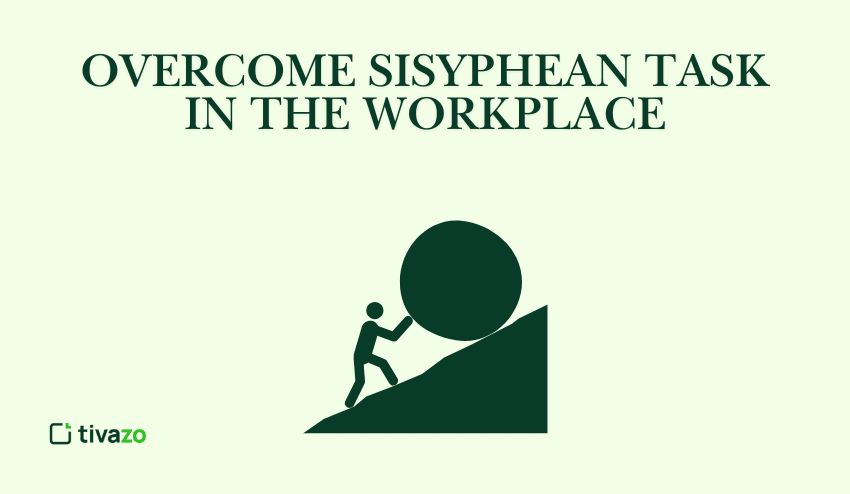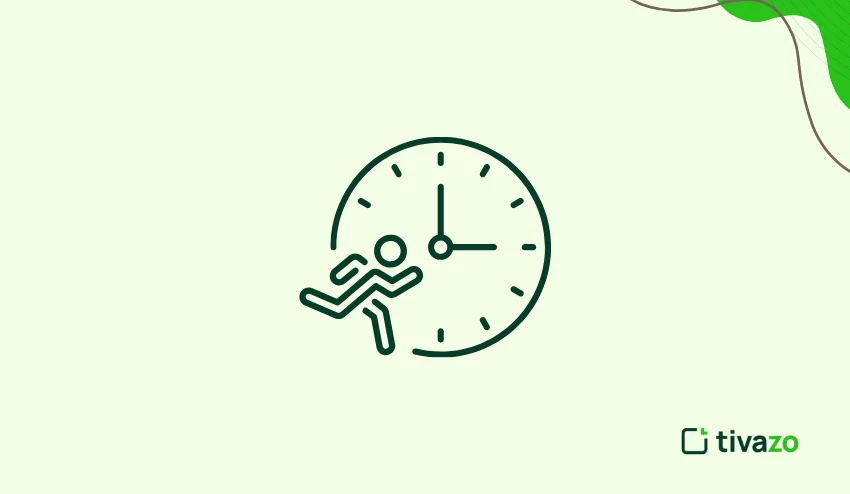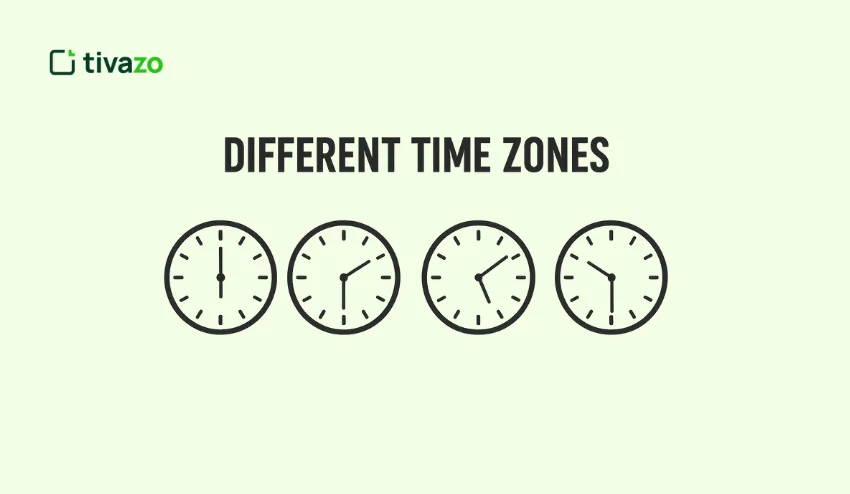There are jobs in every office that seem to be never-ending, the reports you have to rewrite every day, the emails that keep on accumulating, or the projects that need to be updated constantly yet never actually get started. They are what most would term Sisyphean work, after the Greek legend of Sisyphus, king of Thebes, who was cursed to push a rock up a hill, only to roll down again and again. These activities may silently destroy productivity, morale and job satisfaction in the workplace.
It is important to know about Sisyphean tasks both to employees and managers. Their identification enables teams to work on important tasks, minimize burnout, and enhance productivity. Although certain activities are inevitable, it can be used to determine the ones that are actually worthless and the ones that are worthy to make a difference in the manner in which a company runs.
In this guide, we shall discuss what Sisyphean tasks are in contemporary workplaces, reasons why these tasks exist, and above all how to deal with them. Practical strategies to real life case studies, this article offers practical information to anyone seeking to reclaim their time and make work more meaningful.
What is a Sisyphean Task?

Origin of the Term
Sisyphean is a Greek mythology word. Sisyphus was a king who was sentenced to roll a boulder up a hill, and as he was about to reach the summit, he would roll down every time. The penalty was interminable, and this was in vain. A Sisyphean task in the workplace is any activity that seems to be endless, repetitive or ultimately unproductive.
Definition in the Workplace
A Sisyphean task is a task that wastes time and effort but has no significant advancement or outcome. It may entail duplication of reporting, continual reworking or even those that are never completed. Working on such tasks may leave the employees feeling trapped, frustrated, demotivated or unhappy.
Characteristics of a Sisyphean Task
- Repetitive: The task is repeated or the task involves repeating the same procedure.
- Inconsistent Outcome: No specific goal or result is identified.
- High Effort, Low Impact: This one consumes a lot of energy but gives low value.
- Never Fully Finished: Work appears to have no end, and gains or loses ground.
- Demotivating: Causes stress, frustration, or disengagement in the employees.
Why It Matters
Knowledge of what is considered Sisyphean tasks can assist employees and managers in determining weaknesses in the workflow. Through the identification of such tasks, organizations are able to work on meaningful tasks, minimize burnout as well as enhance productivity among teams.
Common Examples of Sisyphean Tasks in the Workplace
1. Monotonous Office Tasks.
The most typical examples are filling in the same reports each day, keying in the same data into the system more than once or updating the spread sheets indefinitely. They consume time but would have minimal strategic value and employees are frustrated and not engaged.
2. Endless Revisions and Approvals
Projects requiring editing, approval or two-way communication can appear to have no end. Sisyphean work is commonly marketing campaigns, design work or reports which have fallen into a sequence of feedback loops.
3. Constant Firefighting
When employees are forced to spend most of their time on a crisis, although low-value, problems, like correcting IT trouble-shooting problems or solving recurring customer problems, there is not much useful work in the long-term.
4. Tasks with Unclear Goals
Unclear expectations or ever-changing goals in a work may leave the employees in the rut of unproductive work. Without obvious results, it is hard to estimate the progress and the work may appear futile.
5. Industry-Specific Examples
- IT: Repeat debugging the same code without determining the root cause.
- HR: One must fill the forms in the system individually case-by-case.
- Sales: Failure to automate CRM entries.
- Customer Support: Asked to answer the same questions repeatedly with no way of self-service.
Why Recognizing These Examples Matters
Identification of such sisyphean tasks is the first step towards reducing futile work. Once identified, automation, delegation or workflow redesign are some of the measures that employees and managers can adopt to recover time and energy.
Why Sisyphean Tasks Happen
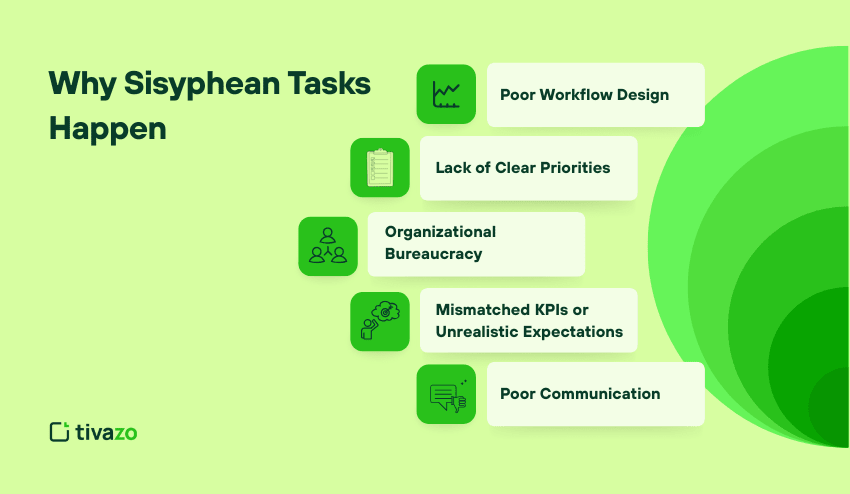
1. Poor Workflow Design
Routine work can be Sisyphean when the processes or the old work methods are not efficient. In cases where the steps are unnecessary or vague, the employees will end up doing the same thing without any significant change.
2. Lack of Clear Priorities
In the absence of priorities, teams can work on urgent but low-impact tasks. The continuous change of focus may cause the employees to feel that they are going round in circles without achieving anything meaningful.
3. Organizational Bureaucracy
Too many approvals, too many hierarchies and too much paperwork tend to come up with tasks that are more compliance than value creation. Bureaucracy may slack the work and a simple task may be made needlessly repetitive.
4. Mismatched KPIs or Unrealistic Expectations.
In cases where the performance measures are not well formulated or realistic, workers might be compelled to pursue figures instead of achieving results. This may result in duplication of efforts which do not contribute to organizational objectives.
5. Poor Communication
Incomplete instructions, ambiguous goals, or absence of feedback may lead to employees repeating work, or making the same correction, to otherwise useful work, and this makes Sisyphean task.
How to Identify Sisyphean Tasks in Your Workplace
The first step to recovering time, enhancing productivity, and minimizing employee frustration is to identify Sisyphean tasks. Unless they are appropriately rewarded, teams can remain wasting their energy on work that generates minimal or no value. These useless tasks can be identified by the following strategies that assist managers and employees in identifying them.
1. Search Repetitive and Endless Tasks.
One of the characteristics of a Sisyphean task is repetition. The activities that involve frequent updates, daily reporting, or getting approvals repeatedly usually take time without any significant results. To illustrate, the need to manually update a single spreadsheet in several teams or rewrite documents several times without any ultimate approval can be an indicator of Sisyphean pattern.
2. Assess Task Impact
Assess the extent to which every task contributes to organizational objectives or quantifiable results. Sisyphean tasks are the tasks that require a lot of effort and produce minimal outcomes. An example is creating presentations repeatedly which are hardly utilized or making small adjustments that do not make a difference in the performance of the business.
3. Gather Employee Feedback
The workers can best see the tasks that seem pointless. Promote free communication by using surveys, team meetings or anonymous feedback forms. Hidden Sisyphean tasks may be identified by questions such as which daily activities do not feel productive or which activities do you spend hours doing but still do not see results.
4. Apply Time-Tracking and Productivity Tools.
The objective evidence of inefficiency is monitoring the way the employees spend their time. Such tools as Tivazo, Clockify, or project management systems could outline the tasks that are constantly taking hours without significant results. The tasks that are determined by these insights are usually Sisyphean tasks that require intervention.
5. Implement a Review Checklist
To systematically assess tasks, the managers can develop a checklist:
- Is the task objective well-defined and quantifiable?
- Is it part of team or company goals?
- Is it automatable, delegable or eliminable?
- Is it a repetition without merit?
Activities that do not meet these conditions are the best candidates of Sisyphean tasks and should be considered to be redesigned or eliminated.
6. Observe Patterns Across Teams
There are cases when something can be productive when done by a single person, but Sisyphean when done by a number of people. Identify commonalities across departments or teams where the duplication of the same work is apparent or where there are bottlenecks. These observations can be used to identify inefficiencies in the system and not individual frustrations.
Strategies to Overcome Sisyphean Tasks
To get rid of Sisyphean tasks, one will need a mix of intelligent prioritization, process changes, and cultural change. Organizations can increase productivity, employee satisfaction, and business performance by focusing on the underlying causes of futile work.
1. Prioritize and Focus on High-Value Work
Among the most useful approaches, the separation of high-value and low-value tasks should be mentioned. Apply such techniques as the Eisenhower Matrix to classify tasks in terms of urgency and importance. The employees can avoid repetitive work as they can spend more time on meaningful projects by cutting time on repetitive or low-impact work.
2. Delegate or Outsource When Possible
The jobs which do not involve specialized skills can be outsourced or delegated. Junior staff, interns or outside contractors can be given routine administration work, so that high-value employees are not overworked, and Sisyphean repetitions will not drain resources.
3. Automate Monotonous Processes.
Sisyphean jobs can be done away with by technology. Repetitive work in report generation, data entry, or approval can be saved by automating with software such as Zapier, Asana, or Airtable. Automation does not only minimize errors but also enables the employees to concentrate on meaningful activities.
4. Revamp Workflows
Take a critical look at current work processes, as to ways they are duplicative, or ineffective. Processes that require people to perform the same thing over and over can either be streamlined down to manageable tasks, or removed entirely to satisfy the duplication, inefficiency and workload.
5. Establish Clear Goals and Outcomes.
Much of our work can be defined as Sisyphean due to vagueness of purpose or a continuously changing purpose. Clear goals, performance objectives and deadlines establishes clarity for employees when they are done with completing tasks, and begin make their work not feel as wasted time because they will not have infinite work cycles.
6. Promote Constant Feedback and Reflection.
Establish a culture whereby employees will be able to give feedback on workload and task effectiveness on a regular basis. Looking back at what work seems pointless assists in realizing new repetitive work and avoiding the repetition.
7. Check Progress and Revise Periodically.
Some of the tasks can still turn out to be Sisyphean after some time, despite the implementation of improvements, owing to the shifting priorities. Constant supervision, performance evaluation and frequent review of work processes ensure that processes are efficient and meaningful.
Common Mistakes When Addressing Sisyphean Tasks
Organizations with awareness and strategies do not always succeed in getting rid of useless or repeated work. Knowledge of typical errors can assist managers and employees to address these difficulties better.
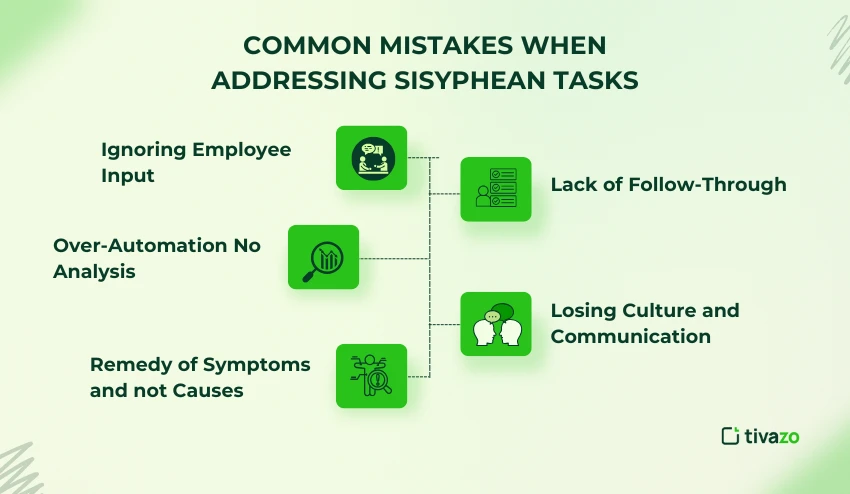
Ignoring Employee Input
The inefficiencies can be first observed by employees who do the work. Ignoring their insights may leave numerous tasks that cannot be completed in the end, which is frustrating and deprives of a chance to improve.
Over-Automation No Analysis.
Implementing automation without workflow analysis may be counterproductive. Wrong processes can be automated and this can lead to errors or redundancy of work instead of eliminating unnecessary activities.
Remedy of Symptoms and not Causes.
It might not be enough to decrease the frequency of reporting or eliminate a step that can address the root of the problem. The inability to fix the underlying problem will lead to the repetition of useless work in a new form.
Lack of Follow-Through
It is not enough to find ineffective activities. Teams are likely to fall back into their previous unproductive ways without tracking results and correcting the processes.
Losing Culture and Communication.
Tasks may appear to be endless even with smooth processes or a work culture that condones unnecessary work. Open expectations, feedback mechanisms, and transparency are necessary to avoid the repetition of inefficiencies.
Conclusion
Sisyphean activities are a latent time, energy and morale drain at the workplace. Organizations can regain productivity and increase employee satisfaction by recognizing repetitive or unproductive work, knowing the cause of the work and establishing workable measures.
Auditing workflows, automation of repetitive processes, establishment of clear goals, and constant refinement of tasks are beneficial to both the managers and employees. Even minor adjustments such as outsourcing low-value work or removing redundant processes can make a significant difference in terms of productivity and involvement.
Finally, fewer Sisyphean tasks will result in a healthier workplace culture, innovation, and enable teams to work on meaningful, high-value projects. Begin with the practical checklist in this guide and enable your team to work smarter, not harder.
